Weekly Topics/Archive
December 2021 |
When I walked out of Goten-mon after finishing the autumn leaves viewing
at Sanzen-in
Temple, I saw two flows of the autum leaves viewers on my left and right.
One is the flow of people returning to the bus stop along the Oharame no
Komichi, and
the other is the flow of people trying to go somewhere with a sense of
purpose in the
opposite direction of the path.
Looking at the clock, it's 14:15.
It's too early to go home.
So, as I didn't have any information near here, I decided to go in the
opposite direction of
the flow of people going home.
If the place I visited is boring, I can go back.
There was a small bridge with bright vermilion in front.
On the nameplate of the parapet, “Mumyobashi Bridge” and “Ritsusen River”
were carved,
whereas on the nameplate of the opposite parapet, “Kayaho-no-hashi Bridge”
and
“Ryosen River” were carved.
It is strange that one bridge has two names.
[Note] Ohara no Sato ; 大原の里、 autumn leaves viewer ; 紅葉客
one 〜 , and other --- ; 一つは〜でもう一つは---、 a sense of purpose ; 目的意識
go in the opposite direction of 〜 ; 〜とは逆の方向へ向かう、 vermilion ; 朱色
Pls click the picture to see a full-size version
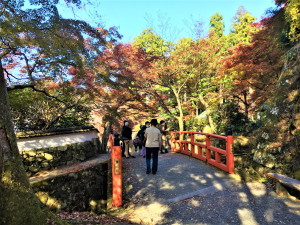 |
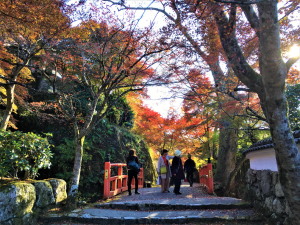 |
Small bridge over Ritsusen River (2021.11:20_14:20)
The bridge name carved on the nameplate
of the parapet is Mumyobashi Bridge |
Small bridge over Ritsusen River (2021.11:20_14:21)
The bridge name carved on the nameplate of
the opposite parapet is Kayaho-no-hashi Bridge |
When I crossed the bridge, I saw a temple in front.
The information board of the temple indicates that this is Shorin-in Temple.
This is the temple of the Tendai sect that is also called Gyozan Daigen-ji
Temple.
Ennin (his posthumous name, Jikaku Daishi) brought back “Syomyo” from Tang
and
handed it down to Enryakuji Temple on Mt.Hiei.
His disciple, Jakugen, founded this temple in 1013 as a training dojo for
Shomyo, and
it became the root dojo for the Tendai Shomyo.
Shomyo is one of the Brahmin disciplines that originated in India.
In Japan, it spread as a temperament to read the sutras of songs that praise the Buddha,
and had a great influence on Japanese music such as folk songs as well
as Buddhism.
(From the information board about Shorin-in Temple)
[Note] Shorin-in Temple ; 勝林院、 Gyozan Daigen-ji Temple ; 魚山 大原寺
Ennin ; 円仁、 posthumous name ; 戒名、 Jikaku Daishi ; 慈覚大師、 Tang ; (中国)唐
Shomyo ; 声明(しょうみょう) (=chanting of Buddhist hymns)、 hymns ; 賛美歌
hand down 〜 ; (後世に)〜を残す、伝える、 disciple ; 弟子、 Jakugen ; 寂源
training dojo ; 修練道場、 Brahmin ; (ヒンズー教)バラモン(の)、 discipline ; 学問
temperament ; 音律、 sutra ; お経、経典、 praise ; 讃える
have an influence on 〜 ; 〜に影響を及ぼす
To put it simply, Shomyo is to chant a sutra with a unique rhythm.
There are two types of rhythm, “Ritsu” in a major key and “Lo” in a minor
key.
It is said that not being able to use the rhythm well is the origin of
the word “Speech is slurred”.
Ritsusen River and Losen River are flowing across Sanzen-in Temple.
It is said that they were named after “Ritsu” and “Lo” of Shomyo.
I decided to enter Shorin-in Temple.
[Note] to put it simply ; わかりやすく(簡単に)言うと、 chant ; 唱える、 rhythm ; リズム、調子、韻律
major key/minor key ; 長調/短調、 speech is slurred ; 呂律が回らない
slur (slurred) ; (音や言葉を)不明瞭に発音する、ろれつの回らない舌で言う
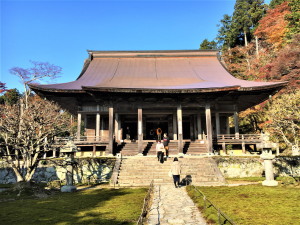 |
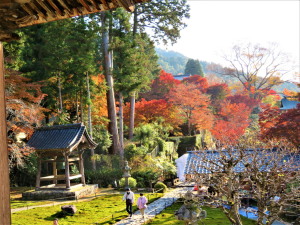 |
The main hall of Shorin-in Temple
(2021.11.20_14:24) |
The view of a bell tower from the hall |
Inside the main hall, there is a device that allows you to hear the actual
Shomyo for
a short time, and you can hear it by pressing the button.
Several visitors were sitting on their heels to hear it.
After leaving Shorin-in Temple and following the flow of people, I got
to Sanmon gate
of Hosen-in Temple, which is adjacent to Shorin-in Temple.
The autumn leaves were at their best here as well.
[Note] sit on one's heel ; 正座する、 Hosen-in Temple ; 宝泉院、 as well ; 同じに、同様にうまく
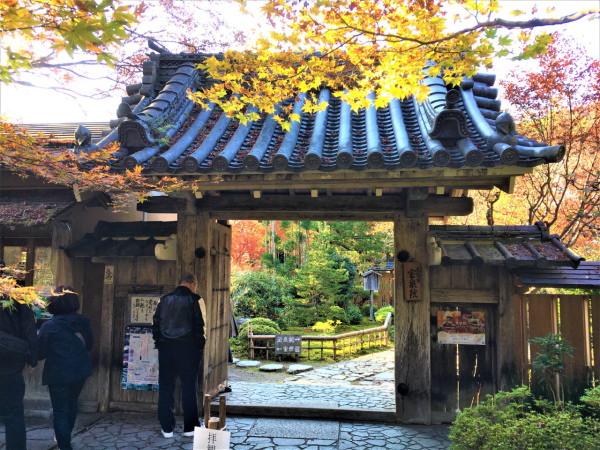 |
| Sanmon gate of Hosen-in Temple (2021.11.20_14:35) |
It was a high admission fee ( 800 yen with refreshments), but I got a
pamphlet and
went inside.
Hosen-in Temple is a Tatchu (sub-temple) of Daigen-ji Temple (Shorin-in
Temple), and
has a history since the end of the Heian period as a dwelling of the chief
priest.
(From the temple pamphlet)
(Tatchu means the sub-temple founded to commemorate the death of a high priest on the
site of the main temple.)
When walking down the hall to Shoin, I saw the Tsuru-Kame Garden spreading
beyond
veranda-like porch on the left of the doorway toShoin.
It is a water garden made in the Edo period.
The autumn leaves in the garden were wonderful.
[Note] refreshments ; 茶菓(tea and cakes)、 Tatchu (sub-temple) ; 塔頭
Shoin ; 書院、 Tsuru-Kame Garden ; 鶴亀公園、 dwelling ; 住居、居住施設
veranda-like porch ; 縁側
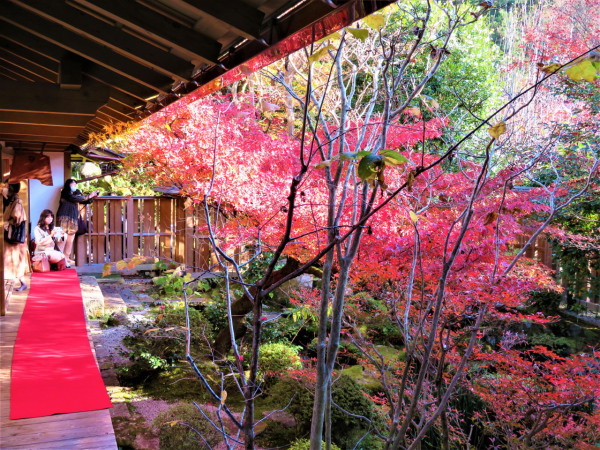 |
| The view of the autumn leaves in Tsuru-Kame Garden of Hosen-in Temple (2021.11.20_14:39). |
At Shoin's room, many visitors seated on the tatami mat were viewing the
garden, while
drinking a cup of Matcha green tea.
The 700-year-old giant five-needle white pine planted in front of the Shoin
is also spectacular.
[Note] Matcha green tea ; 抹茶、 five-needle white pine ; 五葉の松 (needle ; 針)
spectacular ; 壮観な、目を見張らせる
Pls click the picture to see a full-size version
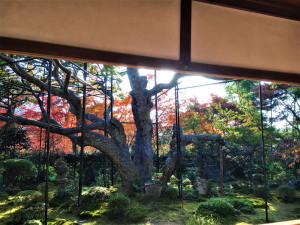 |
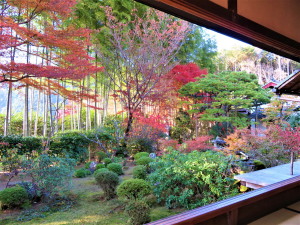 |
| The five-needle white pine (2021.11.20_14:41) |
The autumn leaves and moso bamboo forest
in the Bankan-en Garden (2021.11.20_14:42) |
There is picture-fram garden on the west side of the Shoin.
Visitors can appreciate the garden by using the space between the pillars
as if it were
a picture frame.
The name of the garden is Bankan-en.
“Bankan”(盤桓) is said to mean “It's so wonderful that it's dificuld to leave.”
(From the temple pamphlet)
[Note] moso bamboo ; 孟宗竹、 Bankan-en Garden ; 盤桓園、 picture fram ; 額縁
appreciate ; 観賞する
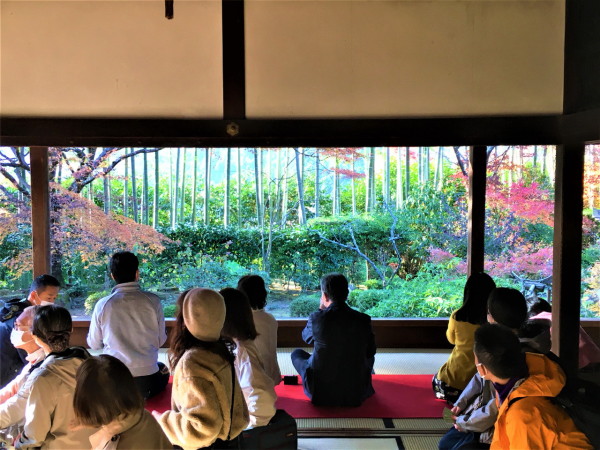 |
| Visitors viewing Bankan-en Garden called the picture-fram garden (2021.11.20_14:48) |
The chief priest gave a Buddhist sermon and an explanation about the temple
to us.
So they helped me to see the temple.
[Note] Buddhist sermon ; 法話
 |
| Visitors listening to the chief priest's sermon and explanations of the
temple (2021.11.20_14:48) |
I also sat down on the tatami mat and enjoyed the matcha service while
appreciating
the five-needle white pine and relaxed for a few minutes.
I thought the admission fee was high, but the matcha fee was included in
it.
The chief priest here is a monk who has a good idea.
Matcha included in the admission fee is like otoshi(a small appetizer)
included in cover
charge in a Izakaya.
The increase in sales will help the temple's finances.
[Note] otoshi(a small appetizer) ; お通し、突き出し、 cover charge ; サービス料
finances ; 財源、 財政状態
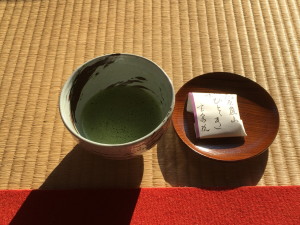 |
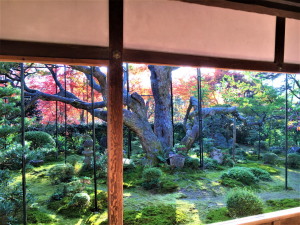 |
| Appreciation of the five-needle white pine while drinking matcha (2021.11.20_14:50) |
It seems that there was a time when it was not served by a resident priest
in the long
history.
When Kyoshi Takahama, a haiku poet from the Meiji period to the Syowa period, visited
here, he composed the following haiku.
「大原や 無住の寺の 五葉の松」 (Ohara ya mujyu no tera no Goyo no matsu)
After enjoying the view from the Shoin, I took a walk in another garden in the precincts,
Horaku-en Garden.
This is a unique dry landscape garden created in 2005.
The autumn leaves in this garden were also very beautiful.
[Note] Kyoshi Takahama ; 高浜虚子、 haiku poet ; 俳人、 compose ; (詩などを)書く、創作する
Horaku-en Garden ; 宝楽園、 dry landscape garden ; 枯山水庭園
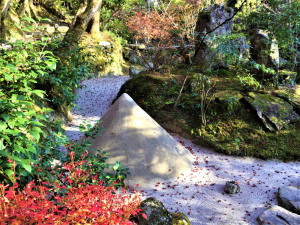 |
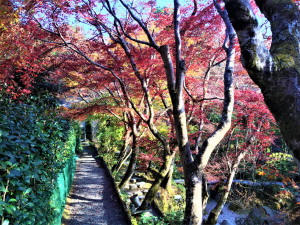 |
The dry landscape garden of Horaku-en Garden
(2021.11.20_14:54) |
The autumn leaves in Horaku-en Garden
(2021.11.20_14:56) |
I spent the unusual luxury time while viewing the tasteful garden.
This is the end of today's autumn leaves viewing.
Turning back on Oharame no Konichi (Oharame's pathway), I head to the bus
stop.
[Note] luxury ; 贅沢な、 tasteful ; 趣のある、上品な
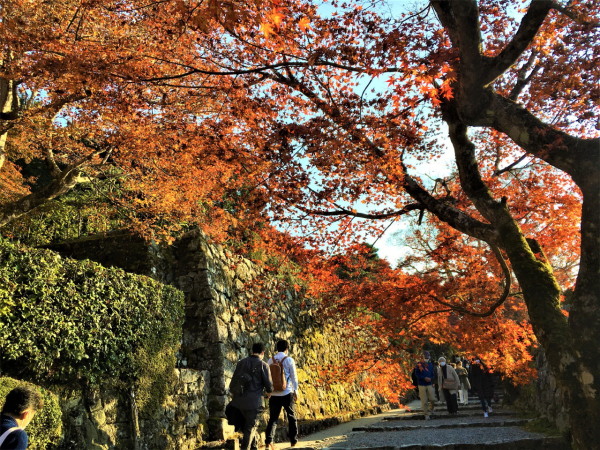 |
| Autumn leaves viewers on their way home (2021.11.20_14:59) |
At Japanese pickles shop “Doi no Shibazuke”near the Sanmon gate of Sunzen-in
Temple, the winter taste of Kyoto “Senmaizuke” is also on sale.
The Syogoin turnips, which is the material of Senmaizuke, also played a role in its sale
at the store.
[Note] Japanese pickles shop ; 漬物屋、 Doi no Shibazuke ; 土井の志ば漬
senmaizuke ; 千枚漬け、 Syogoin turnip ; 聖護院のかぶら (turnip ; かぶら)
play a role in 〜 ; 〜に役割を果たす、〜の一翼を担う
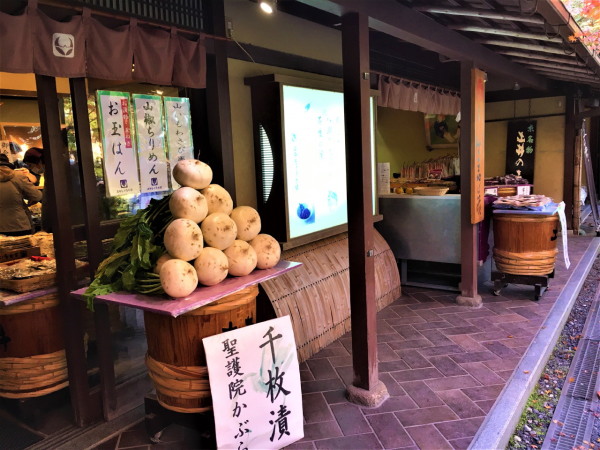 |
| Syogoin turnips which is the material of Senmaizuke (at “Doi no Shibazuke”
shop) (2021.11.20_15:03) |
I went down the pathway along the Rosen River while being reluctant to
leave
the autumn leaves in ohara.
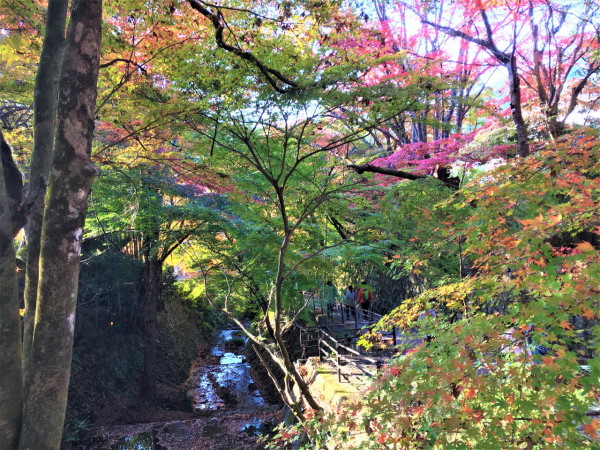 |
| Autumn leaves along the Rosen river (2021.11.20_15:06) |
I got to the cosmos field on the side of the pathway near the bus stop.
The cosmos flowers were in full bloom even though it was almost December.
I entered the field to have a commemorative photo taken with cosmos and
left Ohara.
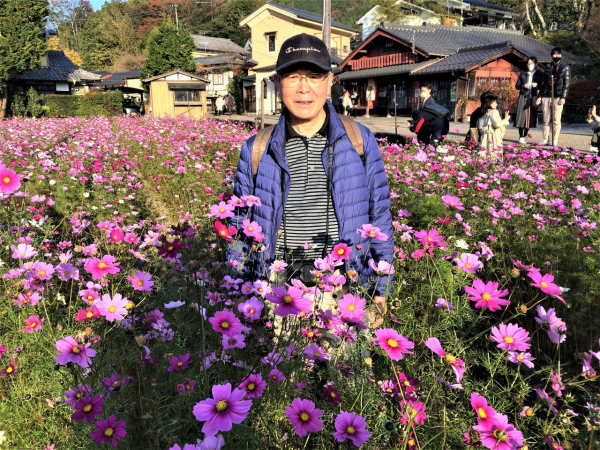 |
| The commemorative photo with cosmos flowers in full bloom (2021.11.20_15:15) |
At the end, I had a drink at the okonomiyaki restaurant Machiya in the
Porta
underground Shokudo-gai in front of Kyoto station, while basking in the afterglow of
autumn leaves viewing.
[Note] okonomiyaki restaurant ; お好み焼き屋、uderground Shokudo-gai ; 地下食堂街
bask in the afterglow of 〜 ; 〜の余韻に浸る (bask ; に浸る、に浴する、 afterglow ; 余韻)
It was a day to enjoy the autumn leaves and beautiful gardens in the historical
old
temples of Kyoto.
Japanese Diary-2.archive / No.1058-2021.11.20 / Diary-2.archive / No.1058-2021.11.20 /
「京都・三千院へ紅葉狩り(3/3) 大原の里 勝林院と宝泉院」
When I walked uphill on the “Oharame no Komichi”, I got to the Sanzen-in
Temple gate,
Goten-mon in about 10 minutes.
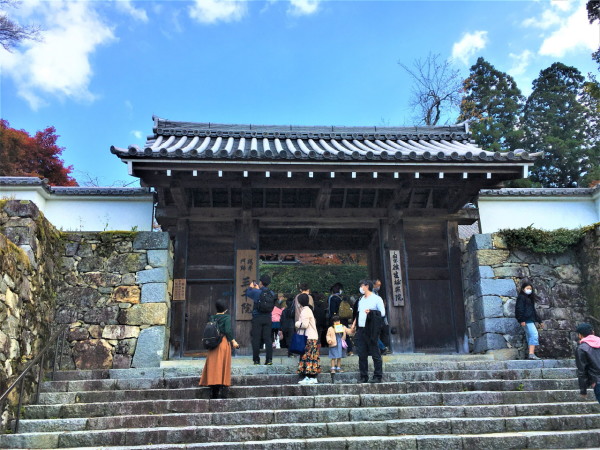 |
| The Sanzen-in Temple gate, Goten-mon (2021.11.20_12:51) |
As you can see in the picture below, many visitors were lining up for
the procedure of
admission in front of the entrance.
It is unavoidable because of the autumn leaves season.
The admission fee is 700 yen.
We get a pamphlet, take off my shoes and head to the Kyakuden (guest hall).
After that, we follow the visitor's route.
[Note] Amida Sanzon-zo (the statue of Amida Triad) ; 阿弥陀三尊像、 triad ; 三人組
procedure ; 手続き、 line up for 〜 ; 〜のために列をつくる、 Kyakuden (guest hall) ; 客殿
visitor's route ; 拝観順路
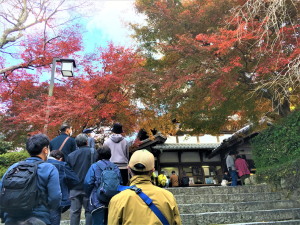 |
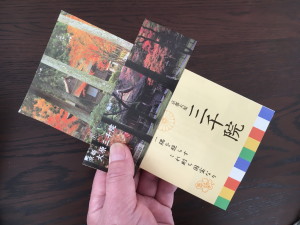 |
A line of visitors waiting for the procedure of
admimission (2021.11.20_12:52) |
The pamphlet about Sanzen-in temple |
According to the pamphlet, the history of Sanzen-in Temple is as follows.
The Ohara area has been known as Gyozan for more than a thousand years.
It is the birthplace of Shomyo (Buddhist sutra chanting) and known as
a sacred spot
in the belief of Jodo (Pure Land Buddhism) among Nembutsu-Hijiri (prayer
mendicant priests).
Sanzen-in Temple was originally established as a hermitage by Saicho (767-822),
or Dengyo Daishi, when he founded Enryakuji Temple on Mt. Hiei, Shiga
Prefecture.
The temple, also known as Kajii Monzeki or Nashimoto Monzeki, is one of the
five Tendai Monzeki temples, and certain members of the imperial family
served
here in the priesthood throughout the temple’s history.
It was officially named Sanzen-in in 1871, according to imperial scroll
written
by Emperor Reigen in the Jibutsu-do hall of Kajii Goten (the temple building),
following the departure of an imperial prince priest from the priesthood.
|
[Note] Gyozan ; 魚山、 Syomyo ; 声明、 Buddhist sutra chanting ; お経を唱えること
belief of Jodo (Pure Land Buddhism) ; 浄土信仰、 sacred spot ; 聖地、 Nenbutsu
hijiri ; 念仏聖
mendicant priest ; 托鉢僧、 hermitage ; 草庵、(人里から離れた)隠れ家
Dengyo Daishi ; 伝教大師、 Saicho ; 最澄、 Kajii Monzeki ; 梶井門跡、 priesthood ;
聖職
serve in 〜 ; 〜に就く、〜の役目を果たす、 imerial scroll ; 勅額、 Emperor Reigen ; 霊元天皇
Jibutsu-do hall ; 持仏堂
The following is Shuheki-en Garden.
It is a Chisen kanshoshiki teien garden (literally., pond appreciation
style garden).
It is said to be reconstructed by Kanamori Sowa, an expert in tea ceremony
during the Edo
period.
The garden dyed in red and yellow with autumn leaves was like a paiting,
and so I stared
at its beauty in fascination.
[Note] a Chisen kanshoshiki teien garden ; 池泉観賞式庭園、 literally ; 文字通りに
appreciation ; 観賞、 expert in tea ceremony ; 茶人、 dyed in 〜 ; 〜に染まった、 〜に染められた
stare at 〜 in fascination ; 〜に見とれる (in fascination ; 魅了されて、魅入られたように、うっとりとして)
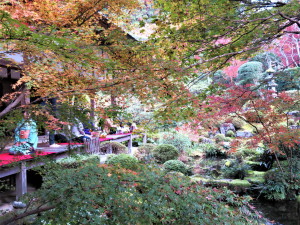 |
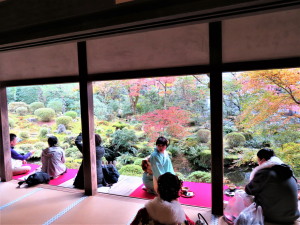 |
| Leaf peeper enjoying matcha and autumn leaves in Shuhekien Garden at the
Kyakuden |
I go to Shinden (emperor's residence) along the corridor.
There was tsukubai (stone wash basin found in Japanese garden) in the courtyard
on the way.
It might be one of facilities that adds a nice touch to the courtyard.
[Note] Shinden (emperor's residence) ; 宸殿、 corridor ; 廊下
tsukubai (stone wash basin found in Japanese garden) ; つくばい、 wash basin
; 洗面器
courtyard ; 中庭、 add a nice touch to 〜 ; 〜に趣(彩り)を添える、
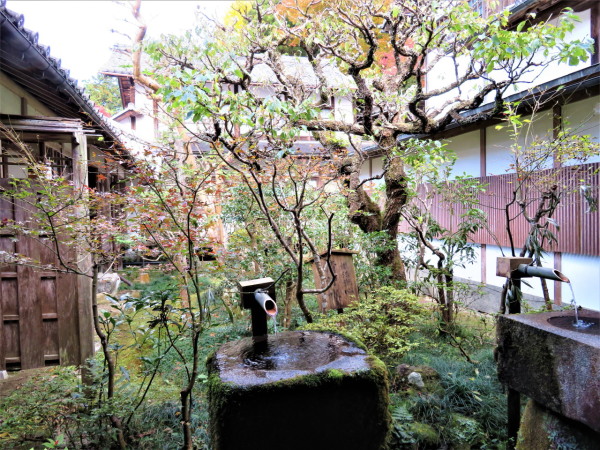 |
| Tsukubai in the courtyard (2021.11.20_13:08) |
Shinden at the main hall is a training monastery that passes down Osenboko
(※)
at Imperial court started by the Cloistered Emperor Shirakawa to the present.
(※) Osenboko is a memorial service of the Imperial Family that had been held
at imperial Court since
the end of the Heian period, and is a ceremony for confessing one's
sins and praying for gokuraku
ojo (paradise).
Yousei-en Park is spreading before this.
This park, which overlooks the Gokuraku-in Hall from the Shinzen, is a
Chisen Kaiyu
style garden ( a style of Japanese garden with a path around a central
pond and spring)
named by Zuo Si (Chinese: 左思), a poet from Later Jin of China. (From the
pamphlet)
The fallen autumn leaves are beautiful in the lush moss garden.
[Note] training monastery ; <仏教>道場 (monastery ; 僧院、修道院)、
pass down 〜 ; 〜を(次の世代に)伝える, Osenboko ; 御纖法講、 imperial Court ; 宮中
confess ; 告白する、懺悔する、 sin ; 罪、罪悪、 cloistered ; 隠とんした、俗世間から離れた
Chisen Kaiyu style garden ; 池泉回遊式庭園、 Gokuraku-in Hall ; 極楽院
Zuo Si ; 左思(中国後晋の詩人)、 Later Jin ; 後晋、 lush ; 青々とした、 moss garden ; 苔庭
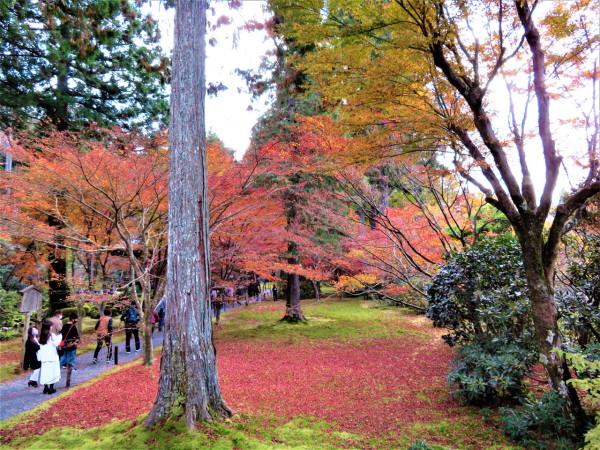 |
| Autumn leaves in Yusei-en park and blanket of fallen maple leaves (2021.11.20_13:09) |
The grove of cedar match with lush moss and autumn leaves to create a
wonderful view.
Pls click the picture to see a full-size version
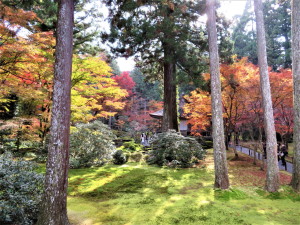 |
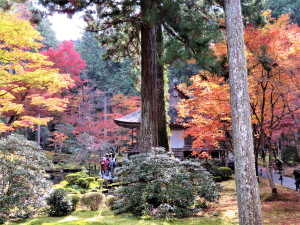 |
| The view of Yusei-en park from the Shinden (2021.11.20_13:13) |
I put on my shoes and head to Ojo Gokuraku-in Hall.
I pressed the shutter button of my camera again to see the stunning beauty
of the blanket
of fallen maple leaves on the moss garden.
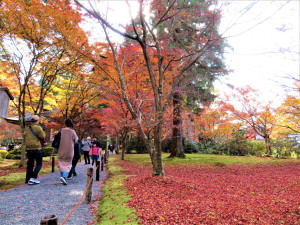 |
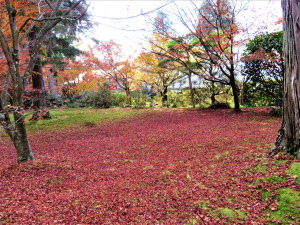 |
| The blanket of the fallen maple leaves that hide the moss garden (2021.11.20_13:18) |
[Note] blanket of fallen maple leaves ; 一面の敷きモミジ、 grove of 〜 ; 〜の木立
cedar ; 杉、 stunning ; 目の覚めるような、素晴らしい、
On the way, I had my commemorative photo taken by a leaf peeper.
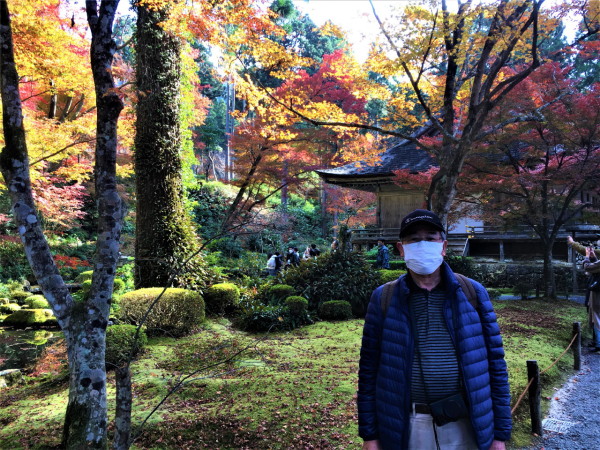 |
| My commemorative photo taen against a background of Yusei-en park |
The following are photos around Ojo Gokuraku-in Hall.
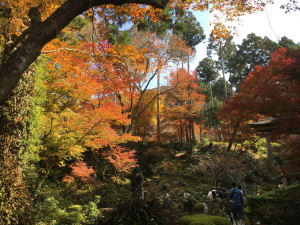 |
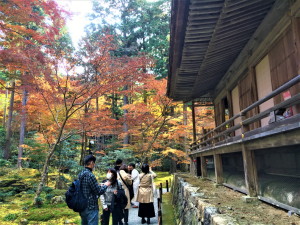 |
| The landscape around Ojo Gokuraku-in Hall (2021.11.20_13:21) |
|
|
| Ojo Gokuraku-in Hall (2021.11.20_13:21) |
I got to Ojo Gokuraku-in Hall (A national cultural important property).
It has irimoya-zukuri, kokerabuki and tsuma-iri.
According to the temple legend, it is said to have been founded in 986
by Eshin Sozu Genshin, who is the author of “Ojoyoshu” and established
the Jod sect, and his old sister, Anyouni to pray for the soul
of his parents.
The ceiling is folded up to the bottom type of ship as a device to accommodate
Amida
Sanzon-zo, which is larger than the Hall.
Nowadays, it is difficult to distinguish it with the naked eye.
But on the ceiling, the figures of celestial maidens dancing in Pure Land
and bodhisattvas
are painted in violent colors. (From the pamphlet)
After I entered the Hall, I took my time to look on the statue while listening
to a monk
about it.
It is a pity that I can't upload the photo because photography was prohibited
in the Hall.
As a pinch hitter, I post a photo from the Sanzen-in Temple's homepage
and a photo I took
from outside the Hall using the zoom function.
[Note] irimoya-zukuri (half-hipped roof) ; (建築)入母屋造り、 half-hipped ;
kokerabuki (thin wooden shingled-roof ; (建築)こけら葺き、 shingle ; 屋根を葺く
tuma-iri (entrance on gable side) ; 妻入り、 gable ; (建築)切妻、破風
temple legend ; 寺伝 (legend ; 伝説、言い伝え)、 Eshi Sozu Genshin ; 恵心僧都源信
Ojoyoshu ; 往生要集、 Jode sect (faith in Pure Land) ; 浄土教
Anyouni ; 安養尼(恵心僧都源信の姉)、 pray for the soul of 〜 ; 〜の菩提を弔う
fold up ; 折り畳む、折り上げる、 Amida Sanzon-zo (the statue of Amida Triad) ; 阿弥陀三尊像
distinguish ; (〜に)気づく、判別する、 with the naked eye ; 肉眼で、
celestial maiden ; 天女 (celestial ; 天空の、天国の、 maiden ; 乙女、少女、 Pure Land
; 極楽浄土
bodhisattva ; 菩薩、 in violent colors ; 極彩色で
|
|
Pls click the picture to see a full-size version
Amida sanzon-zo(taken from outside the Hall↑)
(2021.11.20_13:34)
← Amida Sanzon-zo
(Reference/Sanzen-in Temple's Homepage)
|
According to his explanation : the sitting statue of Amida Nyorai, which
is the center
statue, is 233 cm in hight, sculpted in the yosegi-zukuri (a technique
of constructing
a statue by assembling pieces of wood), covered in gold leaf on lacquer
and pouses
Raigo-in.
Kanzeonon Bosatsu on the observers' right take the form of putting a dead
person on
a lotus pedestal.
Seishi Bosatsu on the observers' left take the form of joining her hand
in prayer.
Both Bosatsu take the traditional Japanese sitting style of kneeling forward
a little and are
full of mercy.
Seishi Bosatsu is identified as the sculpture in 1148 according to Bokushomei
(ink inscription) in her womb
[Note] Amida Nyorai ; 阿弥陀如来、 sculpt ; (〜を)彫刻する、(〜の)彫刻(像)を作る
yosegi-zukuri ; 寄木造、 gold leaf on lacquer ; 漆箔 (gold leaf ; 金箔)
Raigo-in ; 来迎印、 on the observer's right ; 向かって右側に
take the form of 〜 ; 〜の形(形態、姿勢)を取る、lotus pedestal ; 蓮台
pedestal ; (像などを乗せる)台、 join one's hand in prayer ; 合掌する
kneel forward ; 前屈みに跪く、 mercy ; 慈悲、 sculpture ; 彫刻、彫像
Bokusyomei (ink inscription) ; 墨書銘、 inscription ; 銘、記されたもの、 womb ; 子宮
When I looked at this round face, I felt that it was vaguely similar to
the statue of Amida
Nyorai in Byodoin Phoenix Hall.
Then, I head to Konjiki Fudodo.
The maples over the approach path on the way are completely colored and
the scenery is
wonderful.
I can see a signboard that says “Gokaicho(unveiling a Buddhist statue)
of the hidden
statue (a statue rarely shown to the public) of Konjiki Fudomyoo ”.
[Note] be vaguely similar to 〜 ; なんとなく〜に似ている (vaguely ; なんとなく、漠然と)
Byodoin Phoenix Hall ; 平等院鳳凰堂、 Konjiki Fudodo ; 金色不動堂、 hidden statue ;
秘仏の
Gokaicho (unveiling a Buddhist statue) ; ご開帳、 Konjoki Fudomyoo ; 金色不動明王
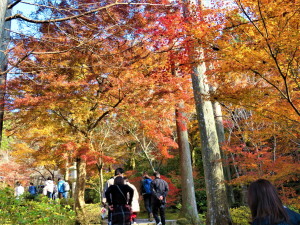 |
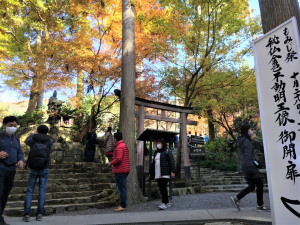 |
Autumn leaves over the approach path to Konjiki
Fudodo (2021.11.20_13:40) |
Signboard that says“Gokaicho of the hidden
statue of Konjiki Fudomyoo” (2021.11.20_13:40) |
Here is Konjiki Fudodo Hall.
The principal image is the hidden Buddha Konjiki Fudo Myo, which is said
to have been
sculpted by Chisho Daishi.
The hall is the main Dojo of prayer that was built in 1989. (From the pamphlet)
|
|
| Konjiki Fudodo Hall (2021.11.20_13:41) |
As the hidden Buddha was unveiled, I visited the Hall to look
on it.
Off course, photography was prohibited in the Hall.
The wooden standing statue of Fudo Myoo (Kamakura period,
98 cm in height), which is said to have been made by Jikaku
Daishi Ennin, is certainly designated as an important
cultural property, but it is not golden.
I wondered if it was different from the Konjiki Fudo Myoo.
The Kannon-do Hall stands on the hill a little away from
the Konjiki Fudo-do Hall, and a statue of Kannon with a height
of 3 meters is enshrined.
I prayed for the health of my family.
[Note] unveil ; (〜の)ベールを取る、(秘密などを)明らかにする
Jikaku Daishi Ennin ; 慈覚大師円仁、 wonder if 〜 ; 〜かどうか不思議に思う 〜ではないかと思う
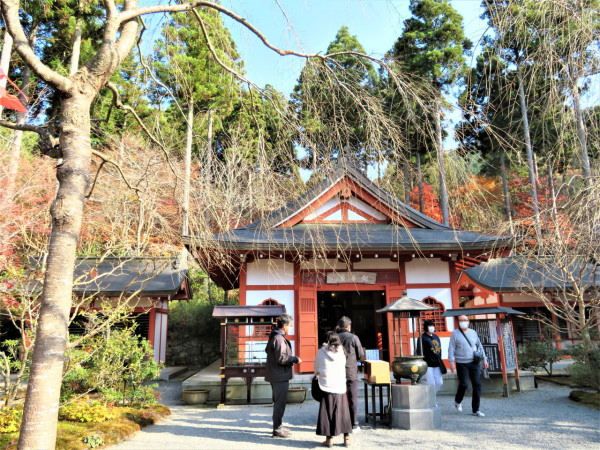 |
| Kannon-do Hall (2021.11.20_13:45) |
I turn back from here.
The view of the cedar grove studded with autumn leaves is also quite good.
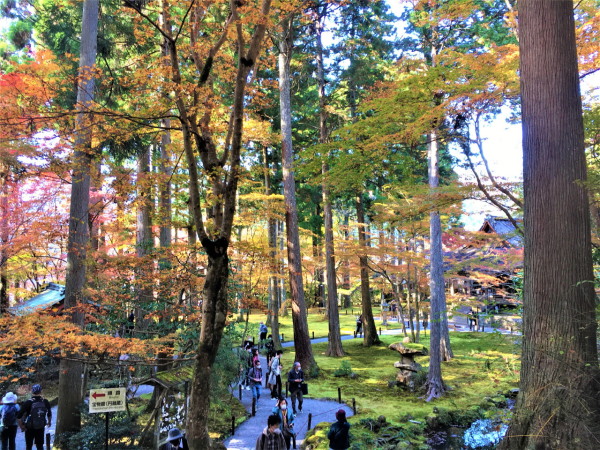 |
| The view of the grove of cedar with colored maple trees (2021.11.20_13:57) |
I got to the area where warabe Jizo are.
Small warabe Jizo were quietly standing around the mossy garden beside
Benten Pond.
The gentle expression and the appearance of holding hands together are
really
heartwarming.
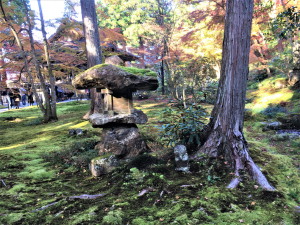 |
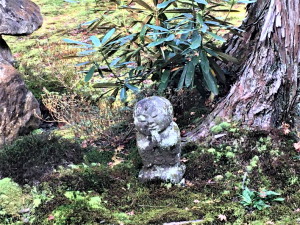 |
| The mossy stone lantern and warabe Jizo in the garden (2021.11.20_14:01) |
[Note] studded with 〜 ; 〜でちりばめられた、 Ojizo-san (stone statue) ; お地蔵さん
warabe Jizo (infant-shaped Jizo) ; わらべ地蔵、 put one's hands together ; 手を合わせる
mossy ; 苔むした、 stone lantern ; 石の灯籠、 heartwarming ; 微笑ましい、心が和む
The following is a photo of the Ojo Gokuraku-in that I stopped by earlier.
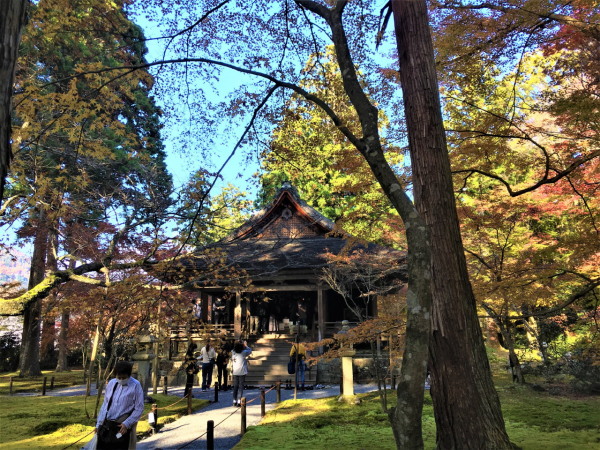 |
| The view of Gokuraku Ojo-in Hall (2021.11.20_14:03) |
Finally, I stopped by the important cultural property storage facility
, “Ennyuzou”, to
look on the exhibits.
On the ceiling, the painting drawn on the ship bottom type ceiling of Gokuraku-in
Hall was
restored and reproduced in full color.
[Note] storage facility ; 収蔵施設、 Ennyuzou ; 円融蔵、 restore ; (〜を)復元する
reproduce ; (〜を)再生/模写/複製する
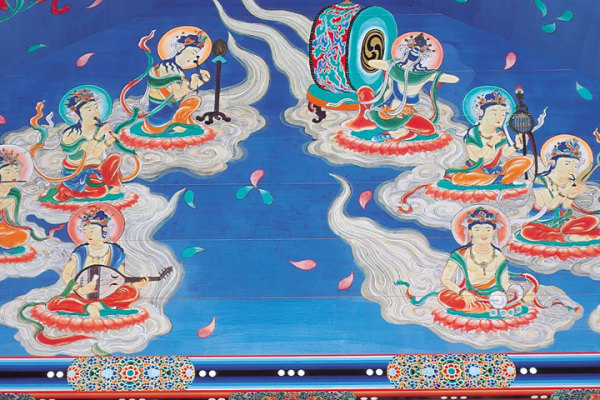 |
The reproduction of the ceiling painting drawn on the ship bottom type
ceiling of Gokuraku-in Hall
[Reference] Sanzen-in Temple's homepage (2021.11.20) |
I never thought that the precincts of Sanzen-in Temple were so large and
full of attractions.
I fully enjoyed the temple as a famous place for autumn leaves.
In addition, I was lucky to see the Buddha, a national treasure.
I left Sanzen-in Temple, imagining that it would also be a picturesque
world
during the season of cherry blossoms in spring, fresh greenery and hydrangea
in summer,
and snowy landscape in winter.
After this, I will visit the nereby Hosen-in Temple.
[Note] picturesque ; 絵のように美しい、絵になる、 fresh greenery ; 新緑、 hydrangea ; 紫陽花
Hosen-in Temple ; 宝泉院
Japanese Diary-2.archive / No.1057-2021.11.20 / Diary-2.archive / No.1057-2021.11.20 /
「京都・三千院へ紅葉狩り(2/3) 三千院境内の紅葉と国宝・阿弥陀三尊像」
To be continued Weekly Topics-2 / No.303-Nov.20,2021 / Weekly Topics-2 / No.303-Nov.20,2021 /
“Trip to Sanzen-in Temple in Kyoto to view the autumn maple leaves(3/3)
−Ohara no Sato Syorin-in Temple and Hosen-in Temple” (Coming soon)
 TOPページへ戻る TOPページへ戻る
|
|